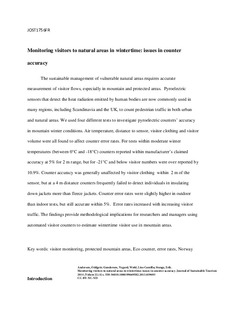Monitoring visitors to natural areas in wintertime: issues in counter accuracy
Journal article, Peer reviewed
Accepted version

View/
Date
2014Metadata
Show full item recordCollections
- Publikasjoner fra CRIStin - NINA [2364]
- Scientific publications [1392]
Original version
Journal of Sustainable Tourism. 2014, 22 (4), 550-560. 10.1080/09669582.2013.839693Abstract
The sustainable management of vulnerable natural areas requires accurate measurement of visitor flows, especially in mountain and protected areas. Pyroelectric sensors that detect the heat radiation emitted by human bodies are now commonly used in many regions, including Scandinavia and the UK, to count pedestrian traffic in both urban and natural areas. We used four different tests to investigate pyroelectric counters’ accuracy in mountain winter conditions. Air temperature, distance to sensor, visitor
clothing and visitor volume were all found to affect counter error rates. For tests within moderate winter temperatures (between 0 C and 18 C) counters reported within manufacturer’s claimed accuracy at 5% for 2 m range, but for 21 C and below visitor numbers were over reported by 10.9%. Counter accuracy was generally unaffected by visitor clothing within 2 m of the sensor, but at a 4 m distance counters
frequently failed to detect individuals in insulating down jackets more than fleece jackets.
Counter error rates were slightly higher in outdoor than indoor tests, but still accurate within 5%. Error rates increased with increasing visitor traffic. The findings provide methodological implications for researchers and managers using automated visitor counters to estimate wintertime visitor use in mountain areas.